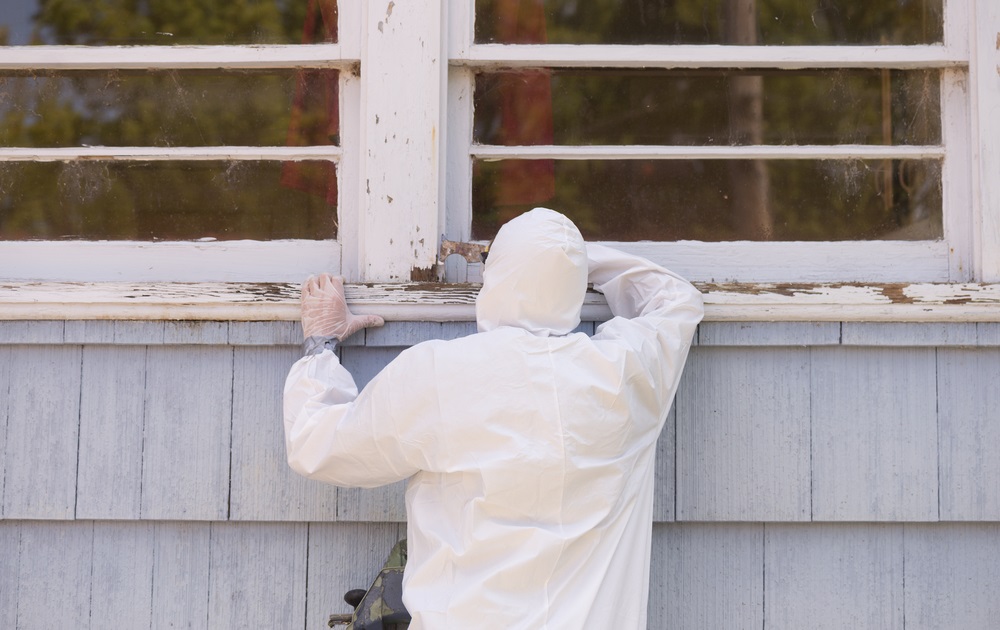The Biden administration this month proposed stricter lead paint regulations for homes and childcare facilities that would strengthen cleanup requirements and lower legal lead thresholds. The Environmental Protection Agency said further reducing lead can limit the damage the metal can have on children who are exposed to it. Some worry that compliance would be disproportionately borne in lower income and rural settings, where there are fewer alternate childcare options.
‘There is no safe level of lead’
Lead-based paint, which was prohibited nationwide in 1978, is still present in buildings across America, particularly homes, and is often covered up with non-lead-based paint.
David Rosner, a Columbia University professor who has studied the history of lead regulations, says the problem with lead paint lies in its inevitable crumbling into chalky dust. This lead dust subsequently settles on floors and windowsills, where it is within reach of children’s hands and mouths as they crawl and play in homes and daycare facilities. Slowly, this lead dust can accumulate in an exposed child’s bones and bloodstream, where it causes significant developmental and health damage.
The EPA’s July 12 announcement of the proposed rule estimated that up to a half million children under age 6 could be impacted by these stricter standards and noted that “very low levels of lead in children’s blood have been linked to adverse effects on intellect, concentration, and academic achievement.”
Further, the EPA said this effort is part of its commitment to advancing environmental justice because communities of color and lower income children are likelier to face lead exposure “because deteriorated lead-based paint is more likely to be found in lower-income areas.”
In a 2021 report, the Dept. of Housing and Urban Development estimated that roughly 35 million, or 30%, of all U.S. homes still contain lead paint. Of these, 22 million, or 19%, of all homes had significant lead paint hazards like buildups of lead dust on floors and window sills that are higher than acceptable levels. Almost all lead paint hazards are in homes built before 1978, HUD said, with these oldest homes concentrated in the northeast and midwest, which accounts for those regions’ higher concentrations of lead paint hazards.
“The whole history of efforts to do something about this problem really goes back at least a century at this point,” Rosner said. “We now have this explosion of concern because thousands of thousands of children are becoming disadvantaged in life.”
Rosner believes the EPA proposal is long overdue and expects it will encounter opposition from landlords.
The EPA said a 2021 federal court ruling required it to revise two limits it defines on lead paint levels in homes and daycare facilities.
First, the proposed rule lowers the level that can trigger remediation to “no detectable lead,” reflecting the fact that there is no safe level of lead exposure for children.
Second, the proposed rules also lowers the amount of lead allowed to remain in a childcare facility or home after removal or cleanup. The amount of lead that would be allowed to remain would be lowered from 10 micrograms to three micrograms per square foot of floor; from 100 micrograms to 20 micrograms per square foot of window sill; and, from 400 micrograms to 25 micrograms per square foot of window trough.
Lisa Greene, senior director of microanalytical sciences at RTI International, says regulations on lead limits can be updated when new technology increases detection.
“As the people who manufacture portable instruments in the field and who work in laboratories develop new and more sensitive methods, we can measure at lower levels, so the standard follows that science,” Greene said.
Kelly Hoffman, an environmental scientist at RTI International, says it is a common misconception that these risk assessments for lead and water are required.
For over three years, RTI International has been involved with the North Carolina Department of Health and Human Services requiring lead in water testing across all childcare facilities in North Carolina. They are currently working on a state-funded project requiring all North Carolina schools and childcare facilities built before 1978 to have a lead risk assessment for lead-based paint hazards as well.
“These lead risk assessments in general, if they’re not a state requirement, are typically in response to a child that has been reported with lead exposure,” Hoffman said.
Cindy Lehnhoff, the director of the National Childcare Association, recognizes this rule as a public health achievement and believes it is necessary to make kids safer. However, if the new rule does not come with appropriate federal funding, it could push small, local child care centers to close.
Many of those centers operate in areas with few other daycare options. States such as West Virginia, which have a significant number of children residing below the poverty line, are already facing a shortage of childcare facilities. According to the Center for American Progress, 51% of people in the United States live in lower income and rural areas where childcare is limited.
“This proposal won’t apply to big childcare facilities because most of them did their expansion in the 80s,” Lehnhoff said. “The rest of licensed childcare are large family homes and centers that are small businesses, so, I have to hope whoever put the rule in place would also become advocates for funding, otherwise, those small providers that are licensed will not be able to continue,” Lehnhoff said.
***
Claire Becknell is a Georgia-based student reporter who covers youth, gender and other topics.
***
This story was corrected on Aug. 2, 2023: An earlier version of this article misstated Lisa Greene’s title. She is senior director of microanalytical sciences at RTI International, not director of quality operations. An earlier version of this article also mischaracterized the purpose of the Water Infrastructure Improvements for the Nation Act and a statement from Greene regarding the status of states seeking EPA funding. Both apply to lead in water, not lead risk assessments.






























